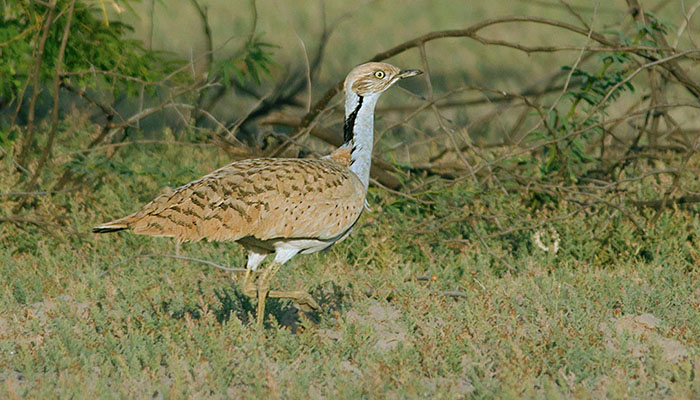
English: Chlamydotis undulata (Jacquin, 1784)
Russian: Дрофа-красотка
German: Steppenkragentrappe
French: Outarde de MacQueen
Mongolian: Жороо тоодгой, Жороо тоодог
Japanese: フサエリショウンガン (Fusaeri-shonogan)
Status: Very rare species. According to the IUCN Red List categories and
criteria, the species evaluated as-Vulnerable.
Distribution and Range: Semi deserts of Central Asia, Arabia and Africa. In Mongolia,
the Great Lakes Depression, the Valley of the Lakes, Southern Altai Gobi, Galba
Gobi and Nomin Govi. Occurs occasionally in the Gobi and desert mountains at
2700m. Eastern edge of the range extends to the Tsagaan Els in Dornogobi province,
the western edge to the Southern Altai Govi, northern slopes of the Mongol
Altai and Govi-Altai Mountains, from the southern slopes of the Khangai
Mountains to Erdeneburen soum in Khovd province, to the north-west spreads to
Davst and Malchin Soums of Uvs province. Patchydistribution.
Habitat: Ranges across semi deserts, deserts, valleys between mountains up
to elevation of 2700m above sea level. Plains and small sandy hills, with
saxaul, pea trees and pea shrubs, Nitraria
spp., anabasis, sparse spear grass, Salsola
corniculata and Allium polyrhizum.
Population and Threats: It is estimated that there are 200-300 Bustards in Mongolia. A
survey conducted July-September 1975-1981 recorded approximately 50
individuals. 7 individuals were recorded along a transect of 500km from
Dornogobi province through Borzongiin Govi, Southern Altai Govi and Nomingiin Govi
in July-August of 1985, 1987 and 1989. Illegal hunting, breeding habitat
distubances had considerably reduced the population. Falcons and eagles prey on
fledgelings as well as mature adults.
Conservation Measures: Included as Very rare animal in the Mongolian Hunting Law,
Annex, CITES Annex I, the Mongolian Red Book (1987, 1997) and the Asia Red Data
Book for Birds (2001). The Habitat is partially included within the NSPAN.
Further Actions: Research on its distribution, population abundance and
reproductive biology; improve conservation efforts in the habitat area,
increase population through captive breeding programs, raise public awareness
about conservation.